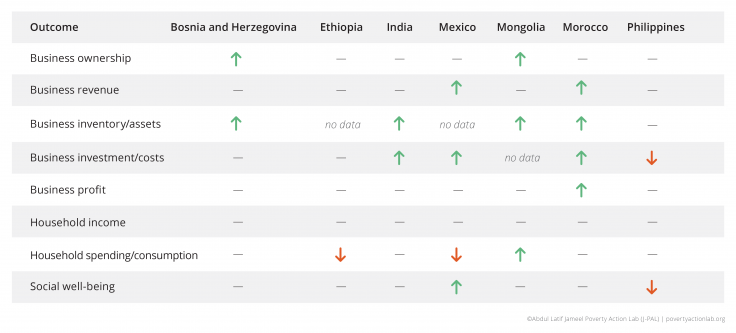Measuring the Impact of Microcredit on Borrowing and Business Outcomes in the Philippines
- Women and girls
- Adults
- Business investment
- Take-up of program/social service/healthy behavior
- Credit
Microcredit is a widely-used tool that has been proposed as a way to help fight poverty and promote economic growth. Researchers measured the impact of individual-liability microcredit on marginally creditworthy applicants in the Philippines. They found that increased access to microcredit expanded borrowing and improved risk management and sharing, but it also led clients to shrink their businesses.
الموضوع الأساسي
Microcredit, or the practice of providing very small loans to the poor, often with group liability, is an increasingly common tool intended to fight poverty and promote economic growth. But microlending has expanded and evolved into what might be called its "second generation," often looking more like traditional retail or small business lending where for-profit lenders extend individual liability credit in increasingly urban and competitive settings. The motivation for the continued expansion of microcredit is the presumption that expanding credit access is an efficient way to fight poverty and promote growth. Yet, despite optimistic claims about the effects of microcredit on borrowers and their businesses, there is relatively little empirical evidence on its impact.
سياق التقييم
First Macro Bank (FMB) is a for-profit lender that operates in the outskirts of Manila. A second-generation lender, like many other Filipino microlenders, FMB offers small, short-term, uncollateralized credit with fixed repayment schedules to microentrepreneurs. Interest rates at this bank are high by developed country standards: several up-front fees combined with a monthly interest rate of 2.5 percent produce an effective annual interest rate greater than 60 percent.
The borrowers sampled in this study are representative of most microlending clients; they lack the credit history or collateral which are needed to borrow from formal financial institutions like commercial banks. Most clients are female (85 percent), and average household size (5.1 individuals), household income (nearly 25,000 Filipino pesos per month), and levels of educational attainment (44 percent finished high school and 45 percent had post-secondary or college education) were in line with averages for the area. The most common business owned by these clients is a sari-sari store, or small grocery/convenience store (49 percent own one). Other popular occupations among clients are in the service sector, such as hairdressing, barbering, tailoring, and tire repair.

معلومات تفصيلية عن التدخل
J-PAL affiliates, with FMB, used credit-scoring software to identify marginally creditworthy applicants based on business capacity, personal financial resources, outside financial resources, personal and business stability, and demographic characteristics. Those with scores falling in the middle comprised the sample for this study, totaling 1,601 applicants, most of whom were first-time borrowers. They were randomly placed in two groups: 1,272 accepted applicants served as the treatment and 329 rejected applicants served as the comparison. These rejected applicants could still pursue loans from other lenders, but it is unlikely they obtained one due to their marginal creditworthiness.
Approved applicants then received loans of about 5,000 to 25,000 pesos, a substantial amount relative to the borrowers' incomes, for example, the median loan size (10,000 pesos, or US$220) was 37 percent of the median borrower's net monthly income. Loan maturity was thirteen weeks, with weekly repayments, and with a monthly interest rate of 2.5 percent. Several upfront fees combine with the interest rate to produce an annual percentage rate of over 60 percent.
Data was collected on business condition, household resources, demographics, assets, household member occupation, consumption, well-being, and political and community participation one to two years after the application process was completed.
النتائج والدروس المستفادة بشأن السياسات
Impact on Borrowing: Being randomly assigned to receive a loan did increase overall borrowing: the probability of having a loan out in the month prior to the survey increased by 9.4 percentage points in the treatment group relative to comparison.
Impact on Business Outcomes: Accepted applicants used credit to shrink their businesses. Treated clients who owned businesses operated 0.1 fewer businesses and employed 0.27 fewer paid employees. One explanation could be that these smaller businesses cost less and are thus more profitable. Perhaps clients would more readily invest in and grow their businesses if loan proceeds are tied to detailed business planning or closer monitoring by the lender.
Impact on Risk Management: Evidence suggests that increased access to formal credit complements, rather than crowds-out local and family risk-sharing mechanisms. Treated clients substituted away from formal insurance into informal risk sharing mechanisms: there was a 7.9 percentage point reduction in holding various types of formal insurance, including life, home, fire, property, and car insurance, and treated clients reported increased access to informal sources of credit in an emergency, such as family and friends. In all, these results suggest that microcredit improves the ability of households to manage risk by giving them additional options: using credit instead of insurance or savings, and strengthening family and community risk-sharing.

Note: Green (red) arrows represent statistically significant positive (negative) differences in outcomes between the treatment and comparison groups at the 90 percent confidence level or higher, dashes represent no statistically significant difference. For more detailed information on the outcomes summarized in this table, please see the full footnote for Table 2 on page 11 of "Where Credit is Due."



